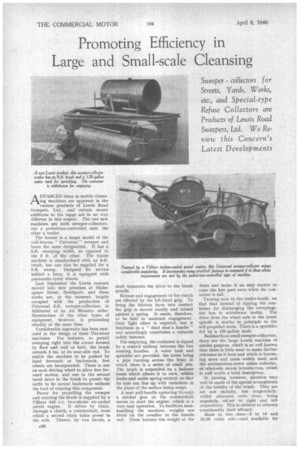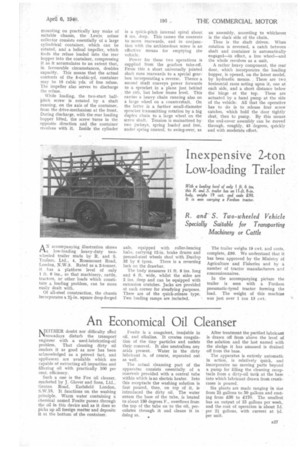Promoting Efficiency in Large and Small-scale Cleansing
Page 36

Page 37

If you've noticed an error in this article please click here to report it so we can fix it.
Sweeper collectors for Streets, Yards, Works, etc., and Special-type Refuse Collectors are Products of Lewin Road Sweepers, Ltd, We Review this Concern's Latest Developments ADVANCED ideas in mobile cleansing machines are apparent in the various products of Lewin Road Sweepers, Ltd., and certain recent additions to the range are in no way different in this respect. The two new machines are both sweeper-collectors, one a pedestrian-controlled unit, the other a trailer.
The former is a larger model of the well-known " Universal " sweeper and bears the same designation. It has a 5-ft. sweeping width, as opposed to the 3 ft. of the other. The trailer machine is standardized with an 8-ft. brush, but can also be supplied for a 5-ft. sweep. Designed for service behind a lorry, it is equipped with pneumatic-tyred wheels.
Last September the Lewin concern moved into new premises at Shakespeare Street, Southport, and these works are, at the moment, largely occupied with the production of Universal 5-ft. sweeper-collectors, in fulfilment of an Air Ministry order. Manufacture of the other types of equipment, however, is proceeding steadily at the same time.
Considerable ingenuity has been exercised in the design of these Universal machines. For instance, to permit sweeping right into the corner formed by floor and wall or kerb, the brush extends 3 ins, at its near-side end. To enable the machine to be pushed by hand forwards or backwards, free wheels are incorporated. There is one on each driving wheel to allow free forward motion, and one in the second bevel drive to the brush to permit the outfit to be moved backwards without the load of rotating this component.
Power for propelling the sweeper and rotating the brush is supplied by a Villiers 249 c.c. two-stroke air-cooled petrol engine. It drives by chain, through a clutch, a countershaft, from which a second chain takes power to the axle. Thence, by two bevels, a shaft transmits the drive to the brush spindle.
Release and engagement of the clutch are effected by the left-hand grip. To bring the friction faces into contact the grip is moved axially and turned against a spring. It needs, therefore, to be held to maintain engagement. Only light effort is required, bat it functions as a " dead man's handle" and accordingly constitutes a valuable safety measure.
For emptying, the container is tipped by a control midway between the two steering handles. A water tank and sprinkler are provided, the latter being a pipe running across the front in which there is a series of small jets. The brush is suspended on a balance beam which allows it to rock, within limits and under spring control, so that its axis can line up with variations in the plane of the surface being swept.
A neat pull-handle operating through a ratchet gear on the countershaft serves to start the engine, which is a very easy operation. To facilitate manhandling the machine, weights are fitted on the crossbar at the handle end. These balance the weight at the front and make it an easy matter to raise the fore part even %%hen the container is full.
Turning now to the trailer-brush, we find that instead of tipping the container for discharging the sweepings, the box is withdrawn bodily. The drive from the wheel axle to the brush spindle it similar in principle to the self-propelled units. There is a sprinkler fed by a 120-gallon tank.
Besides these small sweeper-collectors, there are the large Lewin machine of similar purpose, which is so well known that there is little need to make further reference to it here and which is becoming more and more widely used; and the archimedean-screw refuse collector, of relatively recent introduction, which is well worth a brief description.
In passing, however, mention may well be made of the special arrangement of the bristles of the brush. They are set not radially, hut tangentially, whilst alternate rows cross, being angularly off-set to right and left respectively. This is claimed to enhance considerably their efficacy.
Made in two sizes-5 to 10 and 10-20 cubic yds.—and available for mounting on practically any make of suitable chassis, the Lewin refuse collector consists essentially of a large cylindrical container, which can be rotated, and a helical impeller, which feeds the refuse loaded into the rear hopper into the container, compressing it as it accumulates to an extent that, in favourable circumstances, doubles capacity. This means that the actual contents of the 5-cubic-yd. container may he 10 cubic yds. of free refuse. The impeller also serves to discharge the refuse.
While loading, the two-start halfPitch screw is rotated by a shaft running, on the axis of the container, from the drive-mechanism at the front. During discharge, with the rear loading hopper lifted, the screw turns in the opposite direction and the container revolves with it. Inside the cylinder is a quick-pitch internal spiral about 6 ins. deep. This causes the contents to move rearwards, and in conjunction with the archimedcan screw is an effective means for emptying the vehicle.
Power for these two operations is supplied from the gearbox take-off. From this a short universally jointed shaft runs rearwards to a special gearbox incorporating a reverse. Thence a second shaft conveys power forwards to a sprocket in a plane just behind the cab, but below frame level. This carries a heavy chain running also on a large wheel on a countershaft. On the latter is a further small-diameter sprocket transmitting rotation by a big duplex chain to a large wheel on the screw shaft. Tension is mainatined by two jockeys, spring loaded and free, under spring control, to swing-over, as
an assembly, according to whichever is the slack side of the chain.
Thus is the shaft driven. When rotation is reversed, a catch between shaft and container is automatically engaged—in effect, a free wheel—and the whole revolves as a unit.
A rather heavy component, the rear door, which incorporates the loading hopper, is opened, on the latest model, by hydraulic means. There are two, horizontal rams acting upon it, one at each side, and a short distance below the hinge at the top. These arc actuated by a hand pump at the side of the vehicle. All that the operative has to do is to release four screw catches, which hold the door tightly shut, then to pump. By this means the end-cover assembly can be moved through, roughly, 45 degrees, quickly and with moderate effort.




























































